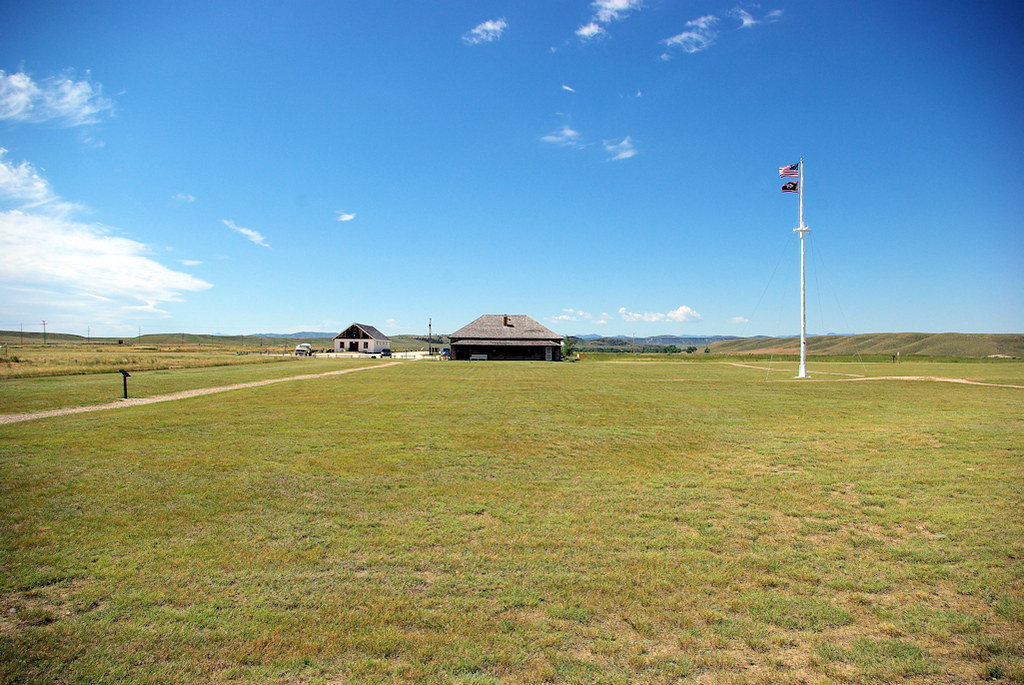Three from the Road #23 – 2010 trip1

Restored Officer’s Quarters, Fort Fetterman
Constructed in 1867 by the US Army, Fort Fetterman was a wooden Great Plain frontier fort approximately 11 miles northwest of present-day Douglas, Wyoming, high on the bluffs south of the North Platte River. While not the site of any major battle, it was the jumping-off point for several major military expeditions against occasionally warring native tribes.2
Established on July 19, 1867, by Companies A, C, H, and I of the 4th U.S. Infantry under the command of Major William E. Dye, the fort was named in honor of William J. Fetterman, killed in a battle with Indians near Fort Phil Kearny on December 21, 1866.2
It contained quarters for three hundred enlisted men, and the necessary officers; the various magazines and store-houses required for the preservation of ammunition, rations and other supplies; a hospital with fifteen beds; stables for fifty horses; a corral capable of holding fifty six-mule wagons, with their animals; a theatre, an ice-house, a root-house, a granary, a bake-house, blacksmith shops, saw-mill, saddlers’ shop, paint shop, laundresses’ quarters and a steam engine for pumping water from the North Platte River.3
On completion of Fetterman, Fort Caspar was abandoned, with the garrison moving to the new fort. With the abandonment of forts to the north – Reno, Phil Kearny, and C.F. Smith – under the provisions of the 1868 Treaty of Fort Laramie, Fetterman became the northernmost military post in eastern Wyoming, important to the protection of the Bozeman Trail and other settler routes.

Fort Fetterman Parade Ground, with Remaining Two Buildings
In it’s remote location, Fetterman was a undesirable posting, with frequent desertions and long, hard winters. Supplies were brought by wagon about 85 miles from Fort Laramie or from Medicine Bow Rail Station, over 150 miles away by trail. Water was carried up the steep bluffs from the North Platte River or LaPrele Creek.2
During the Black Hills War in 1876, a series of major military expeditions set out from the fort. “The Big Horn Expedition, which included three of the post’s four companies under the command of Colonel Joseph J. Reynolds, culminated in a defeat at the Battle of Powder River in March. The Yellowstone Expedition led by Brigadier General George Crook engaged in the Battle of Rosebud in June, and the Powder River Expedition under Colonel Ranald S. Mackenzie destroyed a Cheyenne village in November during the Dull Knife Fight. Fort Fetterman remained active until 1882, when it was abandoned by the Army as the Indian Wars had subsided.”2

Restored Ammunition Warehouse
On May 11, 1882, the military abandoned Fort Fetterman and the governement auctioned the buildings in September, while retaining ownership of the property. While the building should have been removed by their purchasers, a small community – Fetterman City – was started at the abandoned fort as an outfitting point for area ranchers and for wagon trains, with a population of about 500 in 1885. After the town of Douglas was established along the railroad eleven miles away in 1886, Fetterman City declined rapidly. Fetterman didn’t fully succumb until the mid 1890s when the Converse County Stock Growers Association closed their hospital at Fetterman. By 1907, most of the remaining buildings had been moved to Douglas, while others were torn down for building materials. The two remaining buildings served as a ranch house and barn until the State of Wyoming acquired the property in 1962.4
The weather for our July 10, 2010, visit to Fort Fedderman was sunny, cool, and quite windy, as can be seen by the flags on the parade ground in the middle photo. We were camped at the KOA in Douglas, Wyoming.
Endnotes
- Three from the Road is a series sharing images from places we’ve visited. Initially, each post included thee images, related by a randomly selected location or topic. Posts now may be random choices or pre-planned sequences. This post is in a series sequentially sharing images from our 2010 trip west.
- Fort Fetterman – Wikipedia
- Bourke, John (1966). Mackenzie’s Last Fight with the Cheyennes. Argonaut Press Ltd. p. 2.
- Exhibit text, Fort Fedderman State Historic Site, Wyoming, from July 10, 2010 photos
References
- Fort Fetterman
- Treaty of Fort Laramie (1868) – Wikipedia


Comments on this entry are closed.